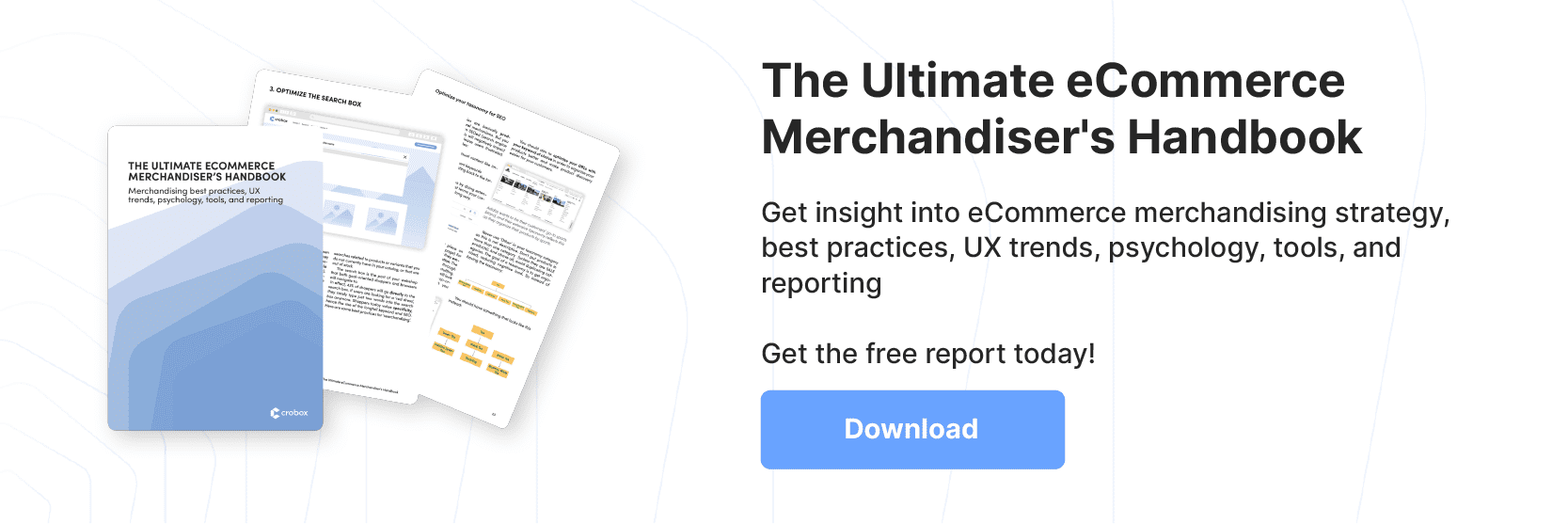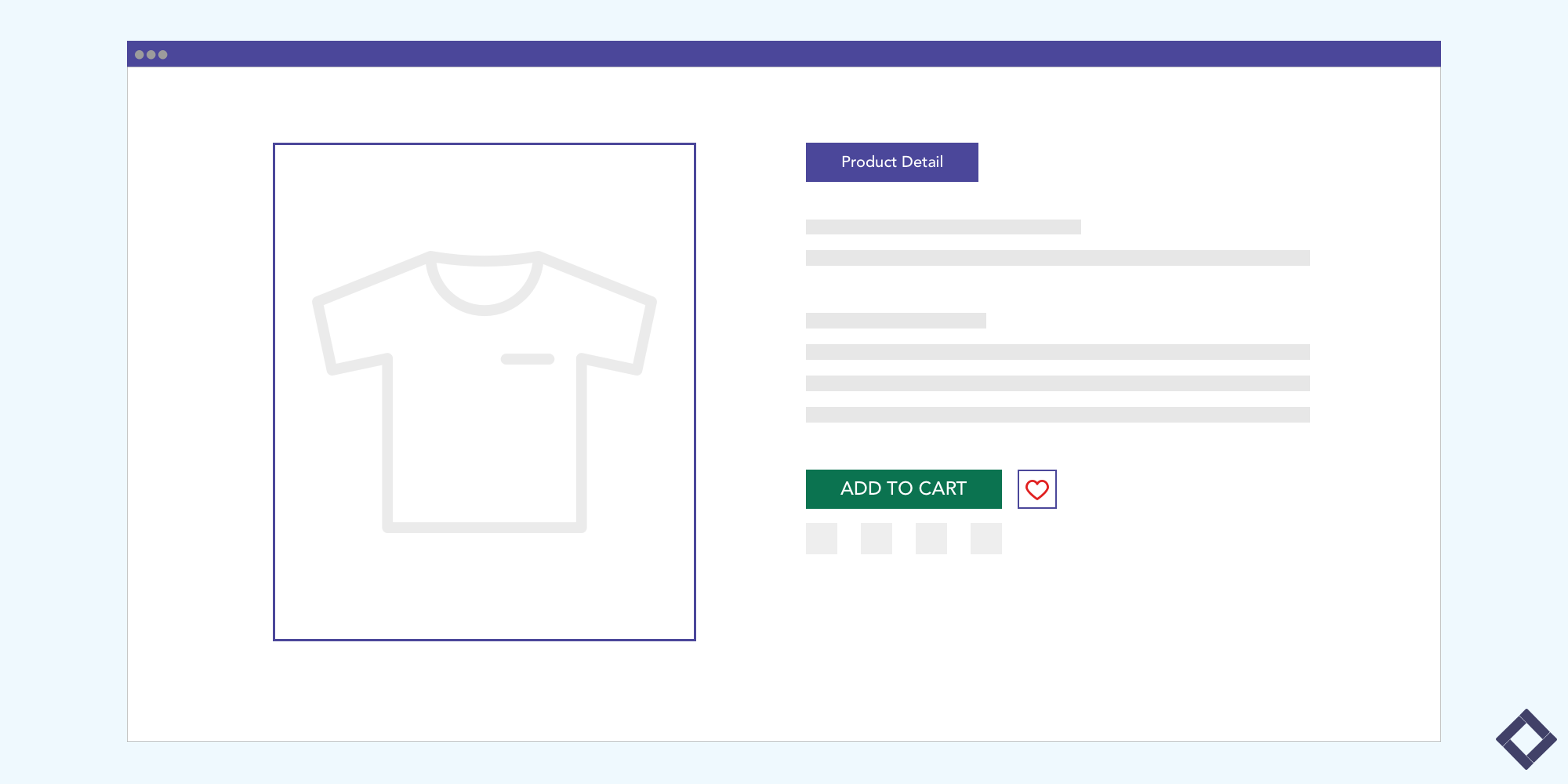What makes a product detail page great? Check out these twenty-six examples with tips on how to apply their tricks yourself.
Imagine you’re browsing a new webshop for the very first time. You’re used to shopping in brick and mortar.
All these online products look great, but you can’t touch them, smell them, or try them on.
This makes product information online all the more important. In fact, 87% of consumers rate product content as extremely important when making a purchase.
More than this, 83% of shoppers need to see product images and photos, while 82% need to read product descriptions, before making a purchase.
So what makes an eCommerce product detail page (PDP) great?
Is it one packed with options and images, full of information, and design quirks that surprise the user?
Actually, no.
The best product pages that we’ve seen are the most seamless, clean, and beautiful in terms of UX design. They are familiar, innovative, and informative.
These twenty-six examples reveal a little about why they’re great according to our team of consumer psychologists.
This is important because understanding your consumers’ psychology in this consideration phase of their journey will help you build the best product pages across your entire webshop and deliver excellent marketing campaigns.
We have a lot to cover, so let’s dive straight in, shall we?
26 Best Product Detail Page Examples: The Best We’ve Seen and Why
1. Bang & Olufsen
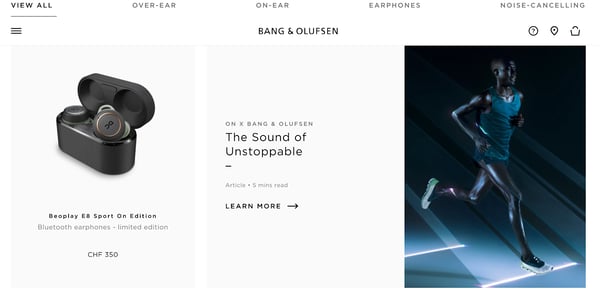
What makes it great:
- Horizontal formatting: This is unique, and optimizes their minimal design by still having all the product information available.
- Product content: Having an extra piece of content around the product offers more information. This also creates internal links to different parts of the webshop - increasing SEO and driving behavior. You can also use articles, customer reviews, or when relevant, blog posts as extra long-form content to provide more information about the product without making the PDP too text-heavy.
- Leverage behavioral principles: Use words that drive purchase behavior to highlight the behavior characteristics of your product. For example, B&O use “Limited Edition”, but you can apply any relevant identifier that fits your tone-of-voice.
2. Buffy Sheets

What makes it great:
- Size and color options: Provide enough options to choose from on the PDP without inflicting choice overload.
- Reviews: Show reviews on the product image to leverage word-of-mouth Social Proof. More People trust their peers more than organizations, so you can boost the appeal of your product by showing how many people liked it or at least reviewed it.
- Option for a “free trial”: This leverages the Endowment Effect, which explains that people attach more value to something that “belongs” to them (something that can be achieved simply by touching a product). Providing free trials will give customers the chance to touch, smell, and see the product in real-life, which will make them feel closer to it.
3. Glossier

What makes it great:
- Tone-of-voice: Shine your brand tone-of-voice through your product descriptions to appeal to your target consumers. The more authoritative your voice, the more people will trust the information you give in your PDP.
- Emulate the in-store experience: Use your product descriptions to show ways of “trying-on” the product. Especially if you’re selling makeup, try using video tutorials or TV-shopping to show ways the product can be used without the customer having to visit your brick-and-mortar store.
- Product badges: For highly rated products, use the product badge “Top Rated” to leverage Social Proof. This reveals what’s appealing about the product on a psychological level.
- Product information subsections: Sections like “why it’s special” and “good to know” break up the products’ attributes and benefits. Describing both in your PDP gives more reasons why the customer should buy the product on both a rational (attributes) and emotional (benefits) level.
4. Manitobah

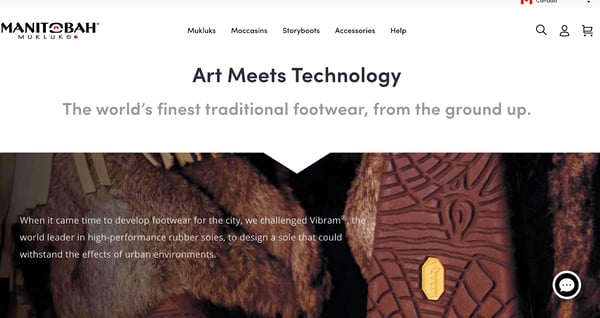
What makes it great:
- PDP tells a story: For Manitobah, the further you scroll down the PDP, the more of the customer can digest the story of the product, from its origins to the material used in its manufacturing.
- Company slogans and taglines: Reusing your brand tagline in your PDP will reinforce your brand ethos and how your products are in line with this (i.e., “International Production. Local Commitment.”, “Art Meets Technology”).
- Close-up product: High-quality images are great extra pieces of information on the PDP, especially close-ups of a material that maybe isn’t mentioned in your product description. They set the scene while showing all the nuanced details of your products.
5. Nudie Jeans
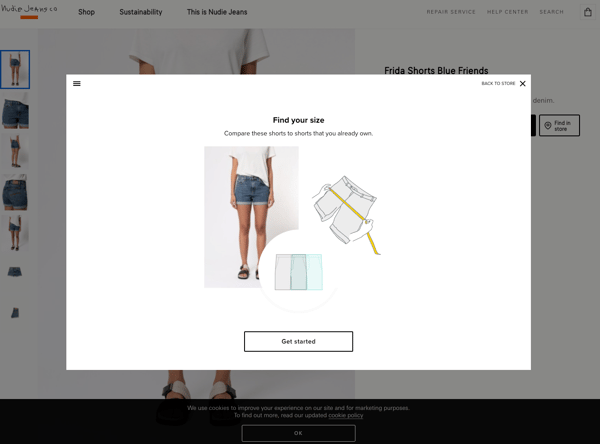
What makes it great:
- Offering a size guide/chart: If you offer a size-guide on your PDP, you can set the rest of their browsing journey in their size default. Plus, getting shoppers to plug in their size by measuring products they own is a personalization tool that will make the experience feel more tactile and personal.
- Default options: Default Options are powerful nudges that streamline and personalize the CX by setting the PDP to a standardized option related to the shopper’s details, most commonly used for size selection. You could also use default options on the PDP for products with complex configurations by choosing the compatible functions for the customer. This will leverage your authority as a brand, whilst also making things easier for the customer (just another sneak peek of nudge marketing from theory to practice).
6. Everlane
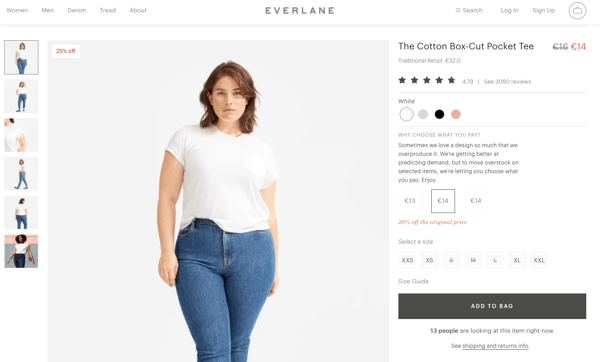
What makes it great*:
- Price anchoring: If your product is discounted, leverage price anchoring to boost its appeal. You should also highlight your anchored prices using different colors (in other words, “contrasting” which boosts the appeal of the discounted price thus making the product more attractive).
- Increasing autonomy: “Choose what you pay” increases autonomy. Increasing autonomy on your PDP is one way to make the product-experience more accessible for the shopper, a nudge that leverages the psychology of self-determination. If the shopper can choose what they pay from three options, this is a good way to give them the illusion of control without inflicting choice overload.
(*We are aware that Everlane is currently under fire for having a toxic workplace. If you want to pursue a radically transparent brand ethos, you should make sure this is mirrored from your supply chain to your frontend employees).
7. Cult Beauty
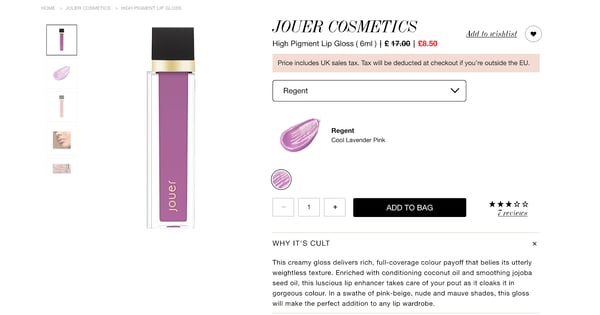
What makes it great:
- Increasing autonomy: Allowing customers to add a product to their wishlist is another way to increase autonomy on the PDP. In addition to this, the shopper can choose how many products they want to add-to-cart before checking out, which streamlines the buyer’s journey and increases autonomy straight from the PDP itself.
- Haptic imagery: Tactile experiences of a product will drive purchase behavior. How do you make something sound like you can touch it in your copy? Use haptic imagery. This is when a product is described in such visual ways that the customer can almost feel the product in real-life!
8. Cariuma

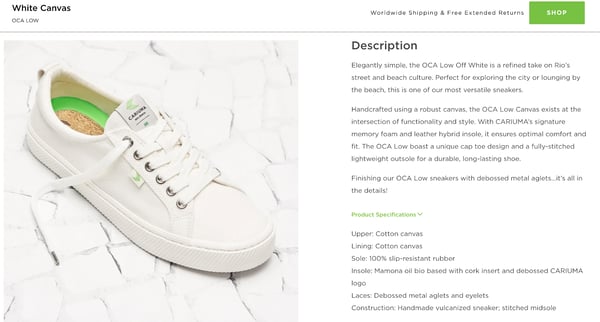
What makes it great:
- Seamless design: When it comes to product descriptions, how you show information is just as important as product content. You could make your product specifications a collapsible click-down box for customers looking for more information without packing the page. For customers scrolling for bare minimum information, this won’t interrupt the UX.
- Integrated product categories: If you’re an independent retailer like Cariuma who offers limited products, there’s no use in having a complex product taxonomy. Instead, put your categories on your PDP in a way that makes it easy for the shopper to choose.
9. Hermes

What makes it great:
- Powerful product descriptions: Despite the power of eCommerce persuasive design, product descriptions would be nothing without their content. Just look at Hermes. They tell an entire story around their scarves, from 1544 to the present (with monsters, myths, and monarchs), and all the famous people who played a part in its conception. However, the amount of text on this PDP is specific to luxury brands. Generally, this amount of text would be a no-go. See what kind of information caters to your target audience, and adapt accordingly.
- Luxury brand storytelling: For luxury brands, stories are powerful because they mark the brand’s heritage and legacy. Moreover, designer culture is closely connected to myths and legends (e.g., Gucci’s bags named after famous people or Hermes’ Birkin bag). That’s because myths create an air of exclusivity, something that luxury brands can really capitalize on in their product descriptions.
- Describing high-quality attributes: The luxury consumer is motivated to buy expensive products because of their unparalleled quality. If you’re selling expensive, exclusive products to this consumer, you should justify your price-points with facts about the high quality of your products.
- Luxury consumers: Another tip for luxury brands is to use CTAs with the copy “discover”, “explore”, or “get inspired” as opposed to “buy now” or “add-to-cart”. From our research on the psychology of luxury consumers, inspirational copy drives behavior better.
10. Nordgreen

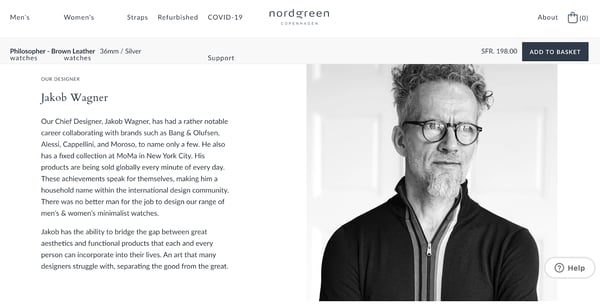
What makes it great:
- Listing product characteristics: If you’re providing a product that you’re well-known for, list the reasons why it’s special on your PDP. This can be anything from the attributes that differentiate it from others in the market, to how it appeals to your target audience. Nordgreen, for example, includes many specifications about their watches attributes to reinforce its authority, technology, and unique design.
- Product videos: 64-85% of consumers are more likely to purchase a product after seeing a product video. Videos are interactive parts of your PDP that will increase page stickiness as shoppers will spend more time looking at the page.
- Leveraging Authority: You can leverage the psychological principle of Authority in different ways. Nordgreen does so by including a bio of the watch-designer, which is a nice, personal touch. You can also use Authority by getting designers to curate wardrobes, tell stories, or by leveraging influencers.
11. Lacoste
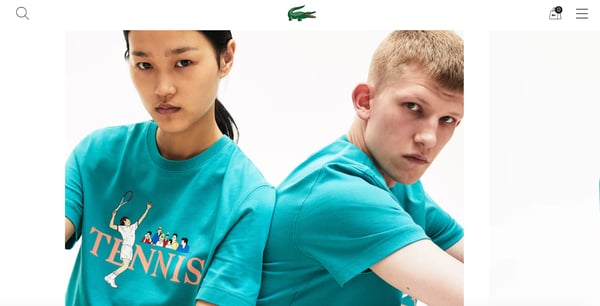
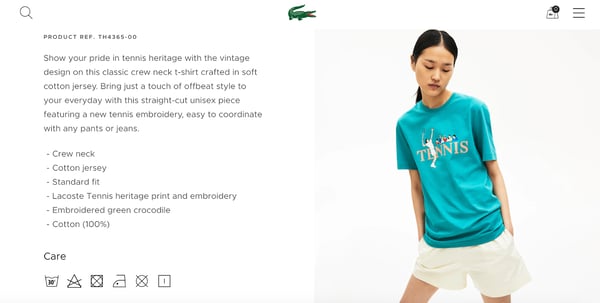
What makes it great:
- Whitespace: More whitespace on the PDP is a sign of luxury, which Lacoste leverages well to boost their brand image. Plus, their PDP balances product information with whitespace in a way that’s aesthetically pleasing to the eye.
- Minimal design: You should also use minimal design to enable processing fluency; the psychology behind design that makes the page easier to process, which means people will enjoy browsing it more.
12. Urban Outfitters
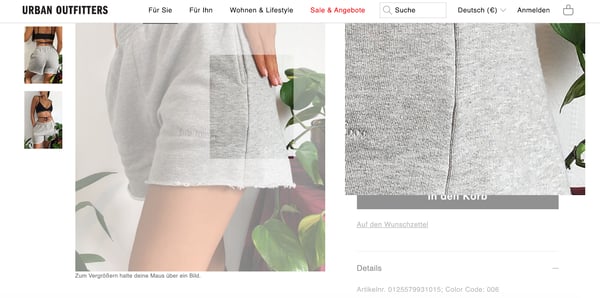
What makes it great:
- High-quality product photos: Urban Outfitters’ high-quality product photos are key to a great PDP.
- Zoom function: Any functions that allow the shopper to zoom, pinch, or customize the product will immediately leverage the Endowment Effect. If you want to minimize the product images on your PDP, this function is a great alternative.
13. Sephora
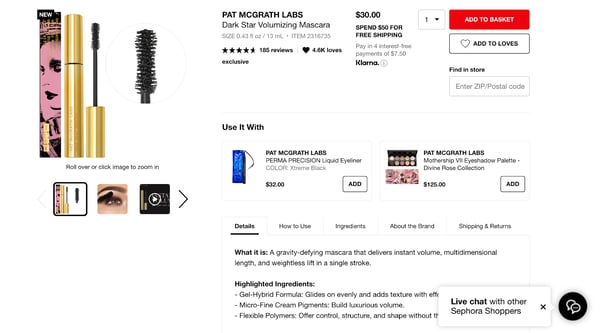
What makes it great:
- Product recommendations: Sephora also leverages product recommendations on their PDP in terms of what the product can be paired with. Normally, product recommendations should be shown further down the page, or at a different stage of the funnel. But since Sephora is selling makeup, it helps the shopper see what the product goes well with.
- Product information subsections: Having subsections of product information means you can track which areas of the PDP your customers click on. And gathering this kind of behavioral data will help you see which areas of your product page should be optimized. Plus, it’s a good way to split the information up to make it easier to read and establish processing fluency.
- Like/love buttons: Increase autonomy by having like buttons work the same as a wishlist. Like buttons or “save for later” also generate data back to the retailer about which products are being saved but not bought, for retargeting or further on-site optimization.
- Live chatbots: Use live chatbots so your customers can ask specific questions to members of your team. This will personalize the customer journey, and emulate that in-store experience most webshops are lacking.
14. Marucci
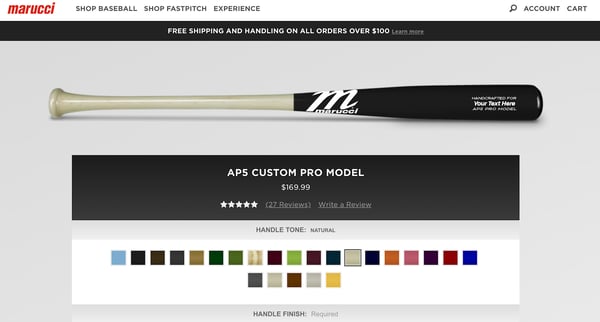
What makes it great:
- Customizable solutions: Marucci is a baseball webshop - pretty niche, huh? But they’re not the only ones who leverage customizable solutions. Lacoste, Ray-Bans, Converse, and many more retailers do the same. This is a great way to let your customers engage with your products and make them more personal. Providing your customers the option to customize products also leverages the Ikea Effect.
- Easy, engaging, and seamless CX: Remember that too many options can inflict choice overload. Don’t overdo it.
15. Sun of a Beach
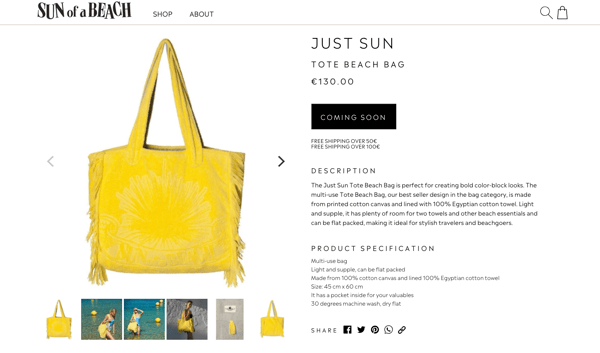
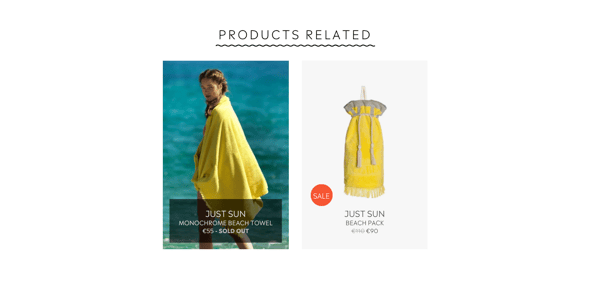
What makes it great:
- Lifestyle product photos: Splitting up the PDP into product photos and lifestyle photos shows what product information different segments are looking for when they shop.
- Hover-text: Placing a description over images can show your customers information like how to wear the product, price, product names, or different patterns without having to take up space elsewhere on the page.
- Product categories based on attributes: You can also split your product categories based on attributes to streamline the customer journey - Sun of a Beach does this on their PLP, for example (IKEA is a good example of a webshop that has a huge product taxonomy. By splitting their categories into subcategories using product attributes, IKEA makes the buyer’s journey less complex and more streamlined).
16. Lush

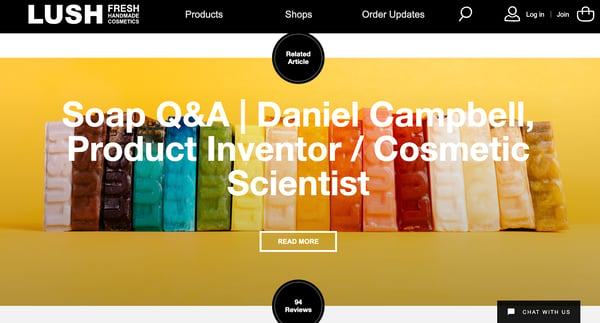
What makes it great:
- Product ingredients: If you’re selling something where ingredients are important, it’s always worth dedicating full sections to this on your PDP. For Lush, who pride themselves on being organic, making the differentiation between “natural” and “synthetic” ingredients resonates with their target audience.
- Customer research: Do market research and social listening to see who your consumers are and what kind of information they want to know when they look at your PDP. Then you can tailor your PDP to this audience by providing articles, reviews, and recommended products.
17. Beatific
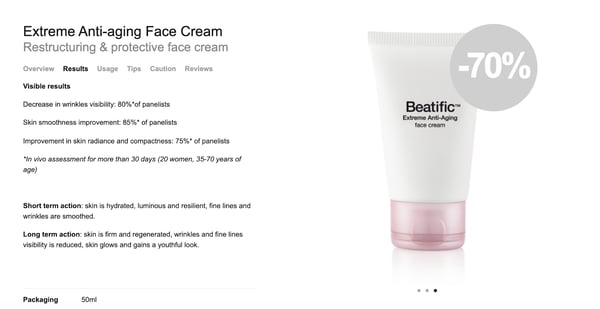
What makes it great:
- Knowing the audience: Beauty/makeup brands all have a different target audience who shop for products based on different things. Beatific, for example, split their PDP into scientifically proven sections, tips, usage, caution, and reviews, instead of showing ingredients like Lush does.
- Leveraging Authority: Leverage Authority on your PDP by giving expert tips, scientific statistics, proven results, etc.
- SEO research: Do keyword research to see what words your customer segments are looking for when searching for similar products. And with that, create titles, meta descriptions, headers, and image alt tags with that keyword for SEO.
18. Allbirds

What makes it great:
- Bullet-points: To make your product information or features more digestible, use bullet points. This will also break up the text to make the design easier to process.
- Iconography: Go one step further and provide icons to visually demonstrate the product’s features. If your brand is product-attributes-focused, then things like materials, shape, sizes, etc., should be highlighted with care on your PDP, and icons could be a good way to demonstrate these.
- But there’s a caveat to the last point! Too much focus on your products’ attributes will lose sight of how the product is customer-centric. A good way Allbirds balances this out is by showing the product in use in one of their product photos and uses the second person “you” in their product descriptions.
It’s the little things that count, don’t you think?
19. Leesa

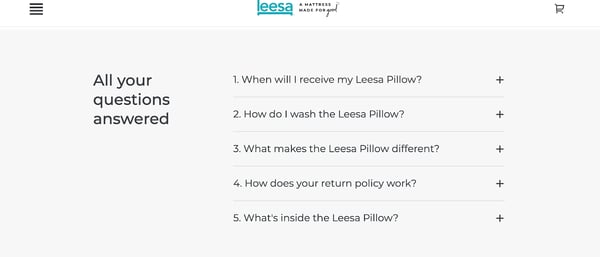
What makes it great:
- Addressing pain points: What’s great about Leesa’s PDP is that it’s super easy to navigate, but also highlights the attributes they think will appeal to their customers. They address their customers’ pain points in their descriptions and say how the product will relieve these.
- FAQ: Provide a FAQ section below, for products that may need extra bits of information. Or go one step further and use chatbots.
- CTA: A brightly colored add-to-cart button will streamline the customer journey as it’s easy to find, and draws attention.
20. Vanmoof

What makes it great:
- Caters to the consideration phase of the customer journey: Vanmoof has a great product page that combines everything from information, customization (“configuration”), delivery, and cost. Their PDP caters to the goal-oriented customer.
- Show what’s special: If you’re selling a product that disrupts the category in which you’re selling (like Vanmoof bikes), then your PDP should highlight this by showing innovative USPs of the product or by comparing it to other products.
- Goal Gradient Effect: The Goal Gradient effect is a psychological principle that when people can see the end of their task in sight, they are more motivated to complete that task. You can also leverage Goal Gradients in your PDP page, but this is usually shown on the checkout page by showing all the steps that are left to be completed before buying a product.
21. Master and Dynamic
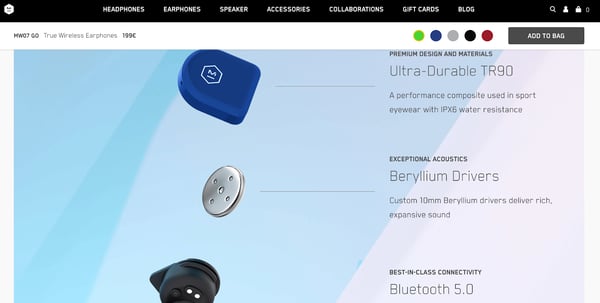
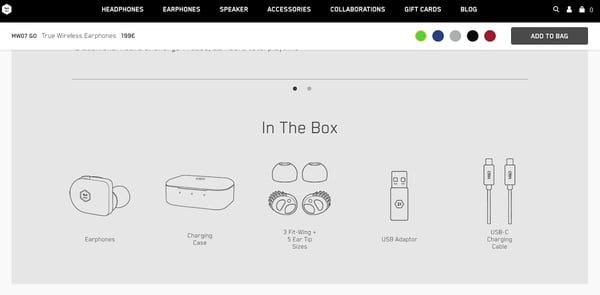
What makes it great:
- Breakdown complex products: Especially if you’re selling electronics, it’s important for your customers to see all the ins and outs of its functionalities.
- Leveraging Exclusivity Scarcity: Use words like “exceptional”, “premium”, “best-in-class” and pair these words with your product attributes (e.g., “Exceptional Acoustics”). When you bring the worlds of product and customer-centricity together, you can make the most out of your PDP.
22. Pandora
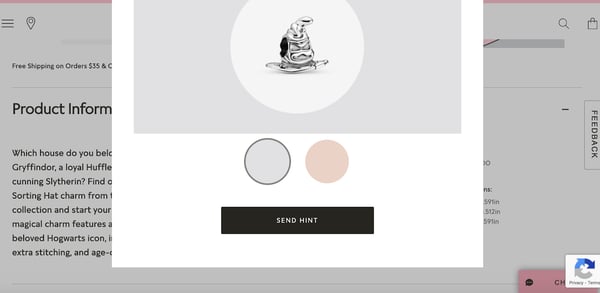
What makes it great:
- Cater to your customer-segments: Pandora’s “send hint” is a way their gift-giving shoppers can really play into their role as gift-givers. They can send an email hint to the person they’re shopping for. If you do have a segment that is primarily gift-givers, personalized tokens of this sort can go a long way. Try offering gift-wrapping options or personalized notes on the PDP.
- Leveraging Social Proof: Gift-givers will respond well to Social Proof because giving gifts is uncertain business. If your shopper can look towards the behavior of others, they will have more confidence in their own choice. Using user-generated reviews, or product badges like “Bestseller” will help this segment understand the product better.
23. Hardgraft
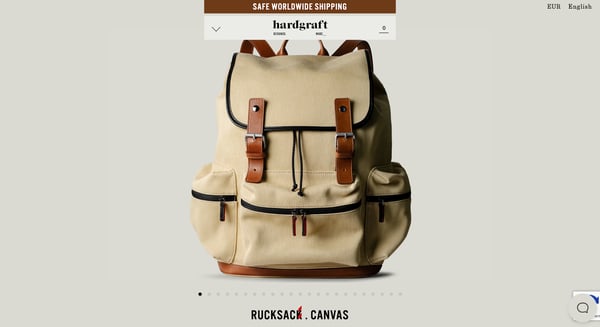

What makes it great:
- Photo gallery: Generally, people prefer images over text. It helps them get a feel for the item without actually touching it. Provide a gallery of photos so the customer has an in-store experience of the product by seeing it from all angles.
24. Bagigia

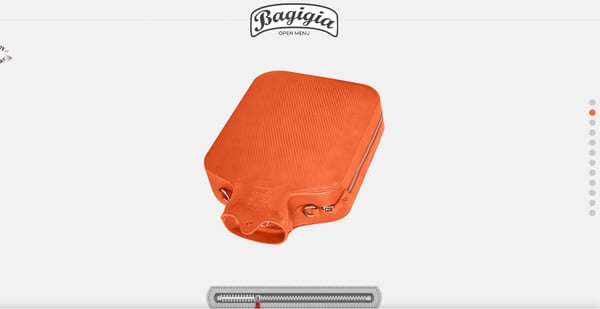
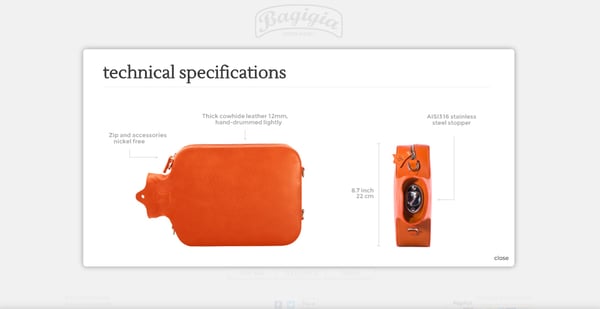
What makes it great (apart form the fact they're selling a luxury hot water bottle...?!):
- Interactive scrolling: Interactive scrolling will provide a delightful UX. But make sure it’s not frustrating to go from one part of the PDP to another. The best way to ensure this stays within the best product page practices is if every page component provides new information without overloading the customer.
- Load-times: Moreover, if you do want to have an interactive PDP, you need to make sure this doesn’t stunt load times on different devices. Keep your images light and test your PDP on mobile, tablet, desktop, etc., to see if they work.
- Interactive product-experience: 49% of consumers don’t like the idea of not being able to try a product online before buying it. The more interactive your PDP engages with the product, the better. Putting exact sizes or dimensions is also important to emulate that in-store experience.
25. Jack Wills
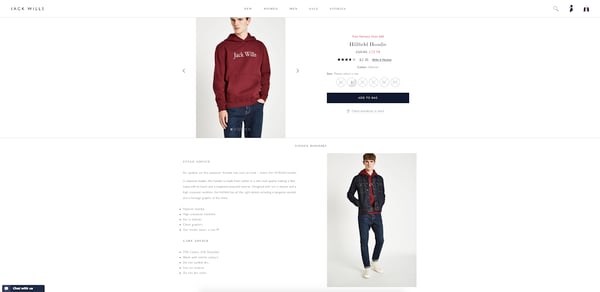
What makes it great:
- Know your audience: Individuals need to sell themselves to the idea of the product. They want to know what benefits they will reap, and the self-identity that products will help them build. If you can talk to your audience in a way they understand, you can help shape the perception of the product.
- Fluency: Preserve your website fluency, especially on the PDP when more information is being given to the shopper. Read about Fogg’s Behavioral Model to see how your product descriptions and images can function as successful “prompts”.
- Style advice: Jack Wills’ PDP builds a story around their product and gives “style” advice so that the shopper can see how the product will impact them in real life.
Wrap Up
So there you have it! Twenty-six of the best PDPs we’ve seen out there. We’ve covered why they’re great through the lens of psychology, and tips on how to apply their greatness yourselves.
With that in mind, it’s up to you to get the ball rolling and create your own best product detail pages.
With strong eCommerce pages, you facilitate product discovery and ensure higher conversion rates. But every retailer knows it’s not just about conversions anymore.
Great product pages are the beginning of customer-centric merchandising. Strong PDP’s foster brand loyalty, whilst keeping customer satisfaction at an all time high.
